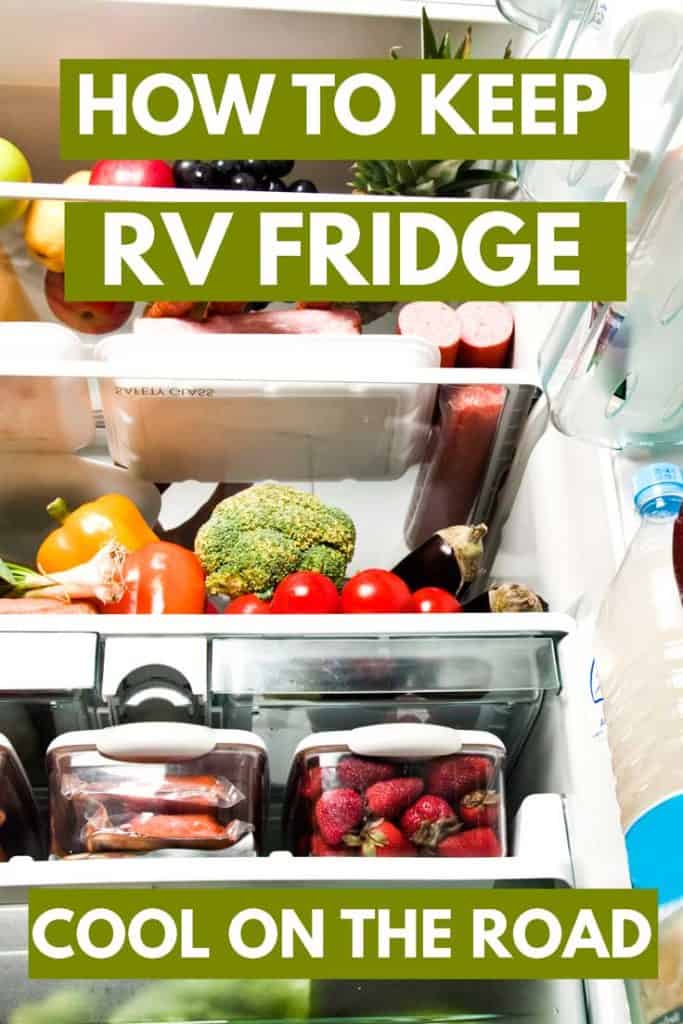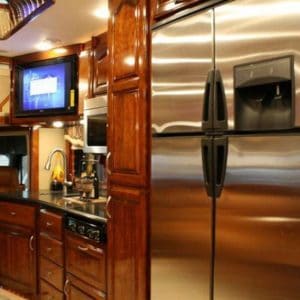You checked several times before you left and your RV fridge was chilled, but now that you’re on the road, it’s hardly cold. What gives? This is a common occurrence for RV owners, so we decided to research why your fridge runs warm when driving and how to prevent it.
 There are several methods to keeping your RV fridge cool on the road, even if you’re not running it:
There are several methods to keeping your RV fridge cool on the road, even if you’re not running it:
- Don’t open the refrigerator door more often than necessary
- Stuff cold items like cans and bottles in empty fridge gaps
- Make sure your fridge is ice cold before you leave
- Use a generator
Ready to start enjoying a cooler fridge? Read on, as we’ll go into more depth about the methods explained above. We’ll also include some precautions for safe fridge use on your RV adventures.
How to Keep Your RV Fridge Cool When Driving
Most of the time, when you are going on a road trip in your RV, your refrigerator will not be running. By doing any of the following, you can prolong how cold it will stay even with no power.
Keep the Refrigerator Door Closed

When you turn up the coldness setting on your RV fridge, the inside temperature of the appliance will gradually drop until it reaches the desired temperature. As soon as you open the fridge door to grab something to eat, you release some of that coldness. The inside temperature of the fridge will go up several degrees as it loses its cold air and gains room temperature air from outside. It then takes longer to get back to that prior cool temperature.
The more you and your passengers go into the refrigerator, the warmer it will start to run. We’re not saying you should starve on your RV, but plan when you’ll get food and drinks strategically. Tell your fellow passengers to do the same. This way, you and several other people aren’t going into the fridge too often.
Alternately, you can bring a cooler and stash what you need for the day in there. Any common household cooler you have lying around should do, but make sure you have lots of ice!
Don’t Leave Fridge Gaps
Avoid fridge gaps as much as possible. You want to fill any empty space with frosty treats such as cold cans or bottles. Small food items that can retain their coldness are another possibility. You don’t want to use ice or anything truly frozen for this job, as it will all melt somewhat. Your food could thaw and go bad, which would be a waste. As the ice melts, it could make your fridge leak. Since RV fridges can be temperamental enough as it is, don’t exacerbate the situation.
There are other factors in packing the fridge properly - many of them relating simply to keeping everything in place while the RV is in motion. You can read more in this guide: How to Pack an RV Refrigerator the Right Way (11 Practical tips!)
Crank up the Coldness
A day ahead of your trip, turn your RV refrigerator to the coldest setting possible. Leave it there overnight. If you must unplug your fridge, at least everything will be ice cold when you do. You might want to be careful about trying to eat or drink anything from the fridge in those first few hours, as they may be bordering on frozen.
Run a Generator
You can also hook up your fridge to your generator to power it up. Then, make semi-frequent stops and run the generator for a while. This should get even a warm fridge back to cold status.
If you do go this route, make sure you’re using your generator in such a way that you don’t annoy other people. Generators are loud devices, and they can release fumes, so keep away from residential areas for certain.
Also, although you probably already know this, never run your generator inside your RV or any other building. It’s possible to die of carbon monoxide poisoning from the fumes. You must also keep your generator several feet away from your RV to allow the fumes to filter into the air and not into your vehicle.
Is Using Propane While Driving a Bad Idea?
RV refrigerators don’t run the same way the ones we use back at home do. Most are two-way, meaning they get a source of electricity (typically alternating current or AC power at 110 volts) but also use propane.
You may have a three-way refrigerator. These run on AC power at the same voltage as well as direct current or DC power at 12 volts. Propane is also used.
Having a three-way fridge can benefit you if you want to keep your refrigerator running while driving your RV. Instead of using AC power, you can rely on the fridge’s 12 volts of DC power to chill your fridge. You do have a higher chance of killing your battery by using this method, so you should only do it sparingly. At least the upside is that you save propane.
Speaking of propane, many RVers wonder if it’s okay to have your fridge running and thus use propane while driving. If you often have a warm fridge, the common-sense answer would be to keep your fridge going even when on the move, right?
It is not safe to use propane while driving. While yes, you do get plenty of benefits, it can all go wrong in an instant. As you drive, you never know what might happen. You could have to make a sharp turn, move to a different lane to avoid road debris, or come to a sudden stop.
These everyday driving scenarios can shift your appliances, including your refrigerator. If it’s not running, then this is no harm, no foul. The coolant and other fluids in the fridge may be jostled a little, but not enough to cause an issue.
When the fridge is running and you shift it even a little, you risk damaging the propane line. It doesn’t have to be your fridge, either. Anything around your fridge that can reach the propane line can cause it to break.
Once that happens, it can be very bad news for you and your passengers. Gas is now able to leak out of the broken line. If there is anything flammable nearby, a fire could start. Your entire RV could go up in flames in a matter of seconds. Such an incident can be fatal. Even if everyone survives, your vehicle will be toast.
It’s even legally mandated in some states that you not drive with the propane running, especially if you’re going through a tunnel. For your own safety and wellbeing, it’s much better not to risk it. You can enjoy a colder fridge following the methods we outlined above without putting anyone’s life on the line.
Turning Your Fridge off While Driving Doesn’t Necessarily Mean Losing Coldness
When you turn your RV fridge off, over the span of eight hours, it will warm up four degrees Fahrenheit. That’s unavoidable, but by pre-chilling your fridge ahead of your trip and going in there sparingly, you can enjoy the coldness longer. You can also plug in your generator if the fridge starts running too warm.
It’s not recommended you keep your refrigerator running while driving. Propane line damage is too high a price to pay for a cold fridge. Remember that there are the above methods, and coolers are also your friend. Good luck!
Before you go, be sure to check out these helpful guides:
